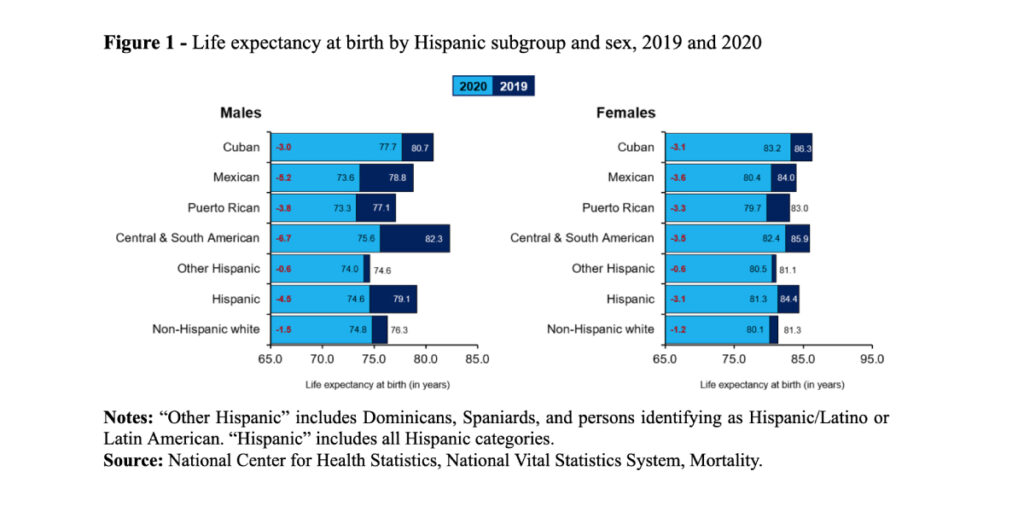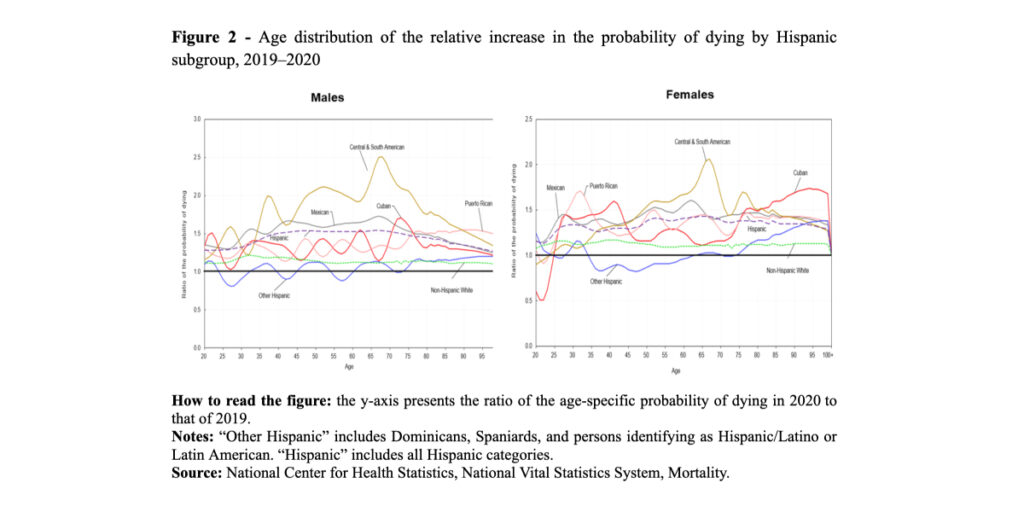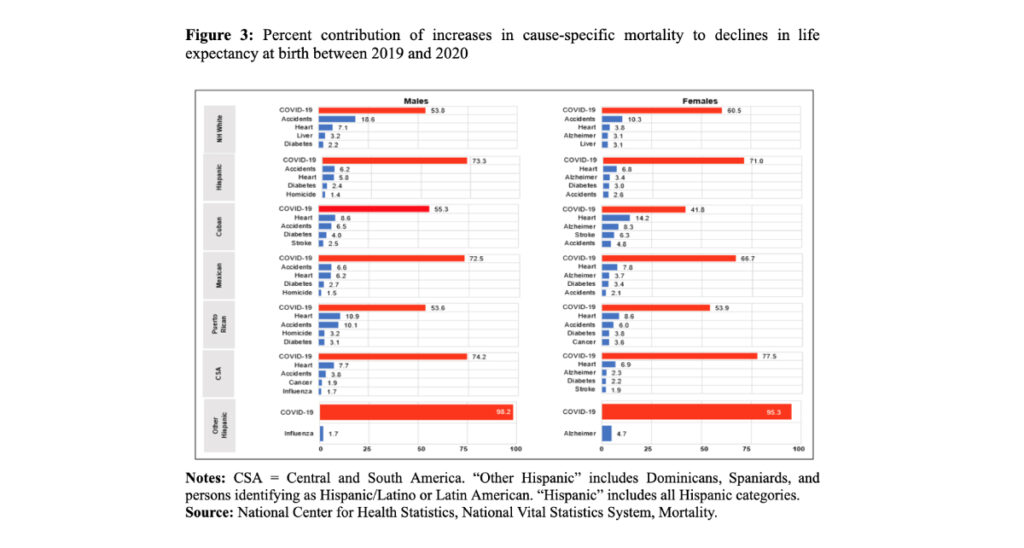In the United States, the Hispanic population was hit harder by the COVID-19 pandemic than the majority (non-Hispanic White) population. Elizabeth Arias and Betzaida Tejada-Vera investigate the matter and highlight a high, but often neglected level of heterogeneity.
The COVID-19 pandemic had a major impact on life expectancy at birth in the United States. In 2020 it fell by 1.8 years, but the drop varied markedly by race and ethnicity, with the Hispanic/Latino (henceforth “Hispanic”) population losing substantially more than other race and ethnicity groups (Arias and Xu, 2022). Before the pandemic, the Hispanic population was characterized by better survival chances than the majority (non-Hispanic White) population, despite having lower levels of educational attainment, higher levels of poverty, and lower access to health insurance and quality care. This advantage, known as the “Hispanic Mortality Paradox”, was almost completely cancelled out by the pandemic, declining from 3.1 years in 2019 to 0.5 years in 2020 (Arias and Tejada-Vera, 2023).
The terms “Hispanic” or “Latino” were created in the US to classify persons from Spanish speaking countries and, as a result, they mask the great diversity of this population (Arias, et al. 2020). Hispanic people have origins in countries representing diverse cultural, economic, social, and political characteristics, and have distinct histories of immigration and patterns of assimilation in the US. Prior to the pandemic this diversity was also evident in differences in life expectancy at birth by country of origin (Arias and Tejada-Vera, 2023). To better understand why the pandemic disproportionately affected the Hispanic population, we examined changes in life expectancy at birth between 2019 and 2020 and the impact of changes in age and cause-specific mortality in Hispanic sub-groups across different countries of origin.
Decline in life expectancy
Figure 1 shows life expectancy at birth in 2019 and 2020 by Hispanic sub-group. The figure highlights differences in both levels and losses in the period, particularly among males. The overall loss of life expectancy among the Hispanic population was 4.5 years for males and 3.1 years for females, ranging from 0.6 (Other Hispanic) to 6.7 years (Central and South American) among males and from 0.6 (Other Hispanic) to 3.6 years (Mexican) among females.

Age-specific variation in the probability of dying
The COVID-19 pandemic increased the age-specific probability of dying during 2020, compared to 2019, differently by age and across the Hispanic sub-groups (Figure 2). For example, Central and South American males experienced probabilities of dying up to 2.5 times greater in 2020 than in 2019, concentrated in the working ages (30 to 70 years), while Cuban females experienced increases close to two times greater, concentrated in the oldest ages (75 and older).

The impact of age and cause-specific changes in mortality on the decline in life expectancy
We used a decomposition technique to explore the effects of changes in age-specific mortality on changes in life expectancy between 2019 and 2020 (see Arias and Tejada-Vera, 2023 for details). For all groups, the effects of increases in mortality below age 20 were minimal. The effects in working ages (20-69) were greater among males across all groups and, conversely, the effects in the oldest ages (70 and older) were greater among females in all groups. There were important differences across Hispanic sub-groups. Among males, increases in mortality at working ages (20-69) were largest for Mexicans (57.4%) and smallest for Cubans (39.5%). Conversely, increases at the oldest ages (70 and older) ranged from 41.3% for Mexicans to 58.4% for Cubans.
Among females, increases in mortality at working ages were smallest for Other Hispanics and Cubans (6.8% and 17.9%, respectively). The largest effects of increased mortality at the oldest ages occurred among Cubans and Other Hispanics (81.4% and 87.1%, respectively).
Figure 3 presents the contributions of increases in the five causes of death with the largest impact on the decline in life expectancy between 2019 and 2020. For all groups, increases in mortality due to COVID-19 had the largest effect on life expectancy loss and its impact was greater among the Hispanic population than among the majority population. There was variation within the Hispanic population, however. The percent contributions of increases in mortality due to COVID-19 were smallest for Puerto Rican (53.6%) and Cuban (55.3%) males compared to Central and South American (74.2%) and Mexican (72.5%) males. Among females, the impact of COVID-19 mortality ranged from 41.8% among Cubans to 77.5% and 98.2% among Central and South Americans and Other Hispanics, respectively.

Conclusions
The impact of the COVID-19 pandemic on life expectancy in the Hispanic population varied by country of origin and sex. This differential impact was also linked to differences in the age distribution of excess mortality due to COVID-19 and in the relative impact of COVID-19 in comparison to other causes of death. These results suggest that for some groups, the excess burden of COVID-19 mortality was an outcome of the over-representation of some Hispanic sub-groups in essential industries with higher risks of exposure to the virus (Riley et al., 2021). For other groups, it may have been the over representation of multigenerational households where older adults were at greater risk of intergenerational transmission of the virus (Riley et al., 2021). These results highlight the importance of population disaggregation in studies of the disproportionate impact of the COVID-19 pandemic on the Hispanic population in the US.
References
Arias E, Johnson NJ, Tejada-Vera B (2020). Racial disparities in mortality in the adult Hispanic population. SSM – Population Health 11.
Arias E, Xu JQ (2022). United States life tables, 2020. National Vital Statistics Reports 71 (1). National Center for Health Statistics.
Arias E, Tejada-Vera B (2023). Differential impact of the COVID-19 pandemic on excess mortality and life expectancy loss within the Hispanic population. Demographic Research 48, 339-352.
Do DP, Frank R. (2021). Using race- and age-specific COVID-19 case data to investigate the determinants of the excess COVID-19 mortality burden among Hispanic Americans. Demographic Research 44, 699-718.
Riley AR, Chen YH, Matthay EC, Glymour MM, Torres JM, Fernandez A, Bibbins-Domingo K (2021). Excess mortality among Latino people in California during the COVID-19 pandemic. SSM-Population Health 15


